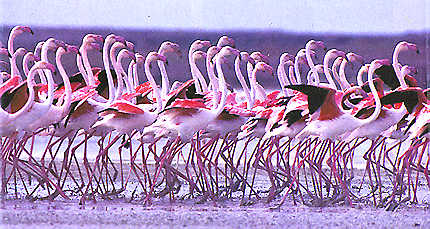
The pond of Moletargius covers more than 1.000 acres and is bordered by Cagliari on
the west and Quartu on the east, Viale Marconi on the north and Is Arenas on the
south. The origins of this pond are very ancient. In fact either a pond or large
marsh existed on this site 100.000 years ago. The exploitation of the pond as a source of salt
is said to have started under Phoenicians, continued under the Spanish, and afterwards
by the Piedmonts. At first people from the villages were employed to collect the
salt during the summer months, then (between the years 800 and 900) prisoners condemned
to hard labor were used. It was this use of the pond that gave it its name. Molentargius
derives from "su Molenti" the small Sardinian donkey which was loaded with sacks
full of salt or which was used to drag the boats into the canals.
During the first thirty years of this century the collecting method was changed. A
system utilizing vaporizing tanks was introduced. The sea water is pumped from the
sea to external basins and from there it is slowly pumped to the central basin. It
then crosses the Is Arenas canal and enters the "salting" tanks in Quartu where the vaporizing
process comes to an end.
Interest in Molentargius is not limited to economic factors. In fact the whole area
is a biotope of great importance, a natural "repository" where thousands of birds
of over 200 different species live.
Despite the building of pylons in the middle of the pond, discharging of waste waters,
progressive in filling, poaching and other forms of pollution, the extraordinary
ornithological patrimony of Molentargius has survived.
Following along ecological campaign, the future of Molentargius seems assured. It
appears to be recovering from the damage and a project for a nature park with museums
and libraries for Molentargius is imminent.
|







